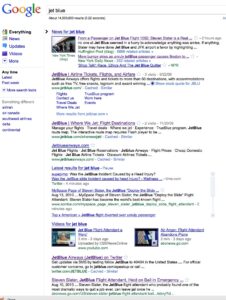As a marketer I rarely, if ever, try to “convince” a law firm or lawyer that social media and networking is something they MUST do. When I speak to groups of lawyers [or marketers] on the topic, I am careful to craft my speeches in a way that presents details, offers illustrations of what others are doing, and I like to share stories about what is or is not working. In other words, I try to give others enough information, pertinent information, which empowers them in making their own decision. But, it’s really more than that…without a need a tool has no meaning.
If you only know how to use a hammer, everything looks like a nail.
Whenever I hear a social media guru preach about the miracles of the social Web and how everyone should be doing this or that, I cringe. It’s like the construction worker who only knows how to use a hammer and so everything starts looking like a nail.
You see, digital communications and the social Web are fantastic tools, but without a need they have no meaning. How could I get in front of a group of strangers—in most cases—and urge them to use tools that they don’t need? If you’re working on your bike and you need an Allen wrench and someone hands you a screwdriver, it just won’t work. The screwdriver has no purpose, no meaning—it’s no use. I guess you could try to force the issue and try to use the wrong tool, but you probably won’t get the results you’re looking for, you’ll be unhappy, and you could waste a lot of time.
Likewise, if you’re not already developing business off-line, or you don’t know how to work a room, write about something people want to read, or understand the buyer and seller process, then you’re probably not going to find the social Web very helpful; it may be the wrong tool for you.
What makes a Rainmaker?
The impulses, skills, and personality types that make great rainmakers aren’t overtly impacted by the tools they use. Their success is the result of their behaviors, such as their ability to listen, see a need and respond.
Sure they need opportunities for exposure, conversation, and relationship and they use a variety of tools and tactics to inform, educate, relate or influence, but the focus is always on people and relationships – people, not tools, buy and use legal services.
For a rainmaker, whatever needs to happen…. well, there is a tool for that. Whether it is buying a table of ten, attending a golf tournament, sponsoring a little league team or getting some PR…whether it is writing a blog post, starting a discussion in an online social networking group, or Tweeting or forwarding articles via email, the best results will come from the operator using the RIGHT tool at the RIGHT time.
Sometimes proof or case studies can help us to identify with and understand our audiences; where they are and what tools might be effective in reaching them. One method is to look at survey data.
What does this data mean to you?
A recently released survey by GreenTarget, zeughauser Group and ALM Legal Intelligence documents attitudes and adoption (Consumption, Familiarity and Use) of New Media by in-house counsel lawyers. You may also find Heather Milligan’s recap of it at the Legal Watercooler Blog helpful, or the original research can be found on the GreenTarget Web site.*
I’m betting there are tons of marketing directors downloading the report right now and walking it down the hall to the managing partner’s office, and I’m really happy for them that they may have something that might help them make the case. You may also want to look at a recently release compilation of AmLaw 100 firms and their use of particular digital tools from MyCorporateResource.com.
*—One note on the GreenTarget research sample. It interviewed only 164 in-house counsel attorneys—there are 25,000 members of Association of Corporate Counsel. I’m not a researcher and I don’t know the answer to this, maybe one of my readers can help me out… Does this type of research work like a “representative sample thing” suggesting that we can conclude from this small sample that it reflects the attitudes of the whole in-house counsel bar? What does this data mean to you?
What this data means to me.
Overall the data is hardly shocking—in the plus or minus column–because I’ve been following how general Internet usage has trended over the years. Pew Internet & American Life project found that in 2009 74% of American adults (ages 18 and older) among a sample of 2,258 adults, (English speaking 2,197) (Spanish speaking 61) were using the Internet. This represents an increase of 25% since 2000-2001. The report that 71% of those use the Internet (search) to find information.
Though any comparison would be apples to oranges, taking into account the educational difference between in-house counsel and the U.S. adult population, it’s interesting to me that:
Pew reports social networking among U.S. adults by age looks like this:
18-32 [67%], 33-44 [36%], 45-54 [20%], 55-63 [9%], 64-72 [11%].
GreenTarget reports social networking among in-house counsel on LinkedIn looks like this:
30-39 [47%], 40-49 [39%], 50-59 [29%] and 60+ [13%]
(Surprisingly, this shows that the only highly skewed number is in the 50-60 range and that may be because the break outs of age range are different.)
Pew reports adult Internet users reading blogs looks like this:
18-31 [43%], 33-44 [34%], 45-54 [27%], 55-63 [25%], 64-72 [23%]
While GreenTarget reports that:
“Blog use, in comparison [to social networking], is more consistent across age groups and company size, demonstrating broad acceptance of the channel as a viable source of news and information.”
“Blogs are the most frequently used tool among in-house lawyers at the largest companies (revenue of $1.5 billion to $9.9 billion) with 35 percent having visited a blog in the past 24 hours, and 54 percent in the past week.”
Inside/Outside counsel.
Another interesting tid-bit from the GreenTarget survey reports how in-house counsel ranked the following activities “most important” for helping them to vet and research outside counsel for potential hire:
- Recommendations from sources you trust 73 percent
- Articles and speeches the lawyer has authored 38 percent
- Bios on the firm’s Web site 30 percent
- Blogs published by lawyers 27 percent
- Rankings and directories 25 percent
- Twitter feeds from lawyers 22 percent
- Endorsements and connections on LinkedIn 18 percent
- Quotes by lawyers in relevant media outlets 15 percent
[The study notes that that 37 % of counsel aged 30-39 rated “blogs published by lawyers” as the second most important activity for helping them to research outside lawyers for potential hire, following “recommendations from sources they trust and many regarded LinkedIn as the most powerful new media platform.]
I’m not surprised to see “recommendations from sources you trust at the top” of the main list…and, would point out that in the right hands social media and networking tools can play a role in becoming known, liked and trusted!
I suppose this research is getting closer to defining a need that all lawyers may want to understand, i.e. if in-house counsel are (or will be shortly) looking to the Web as a primary source for information then you should be feeding the hungry beast and “hanging out” in the same places.
If you want to be present and accounted for and you’re not already there, you may want to start cutting your teeth now…
By that I mean, get out on the Web more often, watch, listen and learn. In the beginning, business development should be the LAST thing on your mind. Get a feel for the tools and learn to enjoy being there before you put pressure on yourself to see specific business results.
Use the social Web as:
- an intellectual exercise
- a creative outlet
- a way to stay connected to a community
- a resource for your practice
- a resource to learn more about your clients
I recently interviewed six attorneys for my forthcoming book social.lawyer: Transforming business development (Thomson West mid-summer). ALL but one of them has been “working on the Web” for many, many years—some their entire adult lives. It takes time to learn how to use the entire tool box…online (or offline!).
So, if the solution to a recognized need points you toward the social Web, relax and enjoy. Take it slow, get help, and ask questions. Remember, it’s your behavior and the way in which you use the tools that matters most, not the tools. When you’re engaged in something you enjoy others often see it as a sign of confidence and self-understanding –all good traits I’d want to see in my lawyer if I were an in-house counsel. If it’s a chore or you don’t see a need and resent doing it, others will see that too….
**One caveat: use social with discretion and be sure to add value! Those in-house counsel often used words like Time, Information, and Credibility–reflecting a collective voice that engaging in social media platforms is extremely time-consuming, that credibility is a serious barrier, and that the sheer abundance of information poses the difficult challenge of discerning between credible and non-credible content.






Great post, Jayne. I wanted to comment on your point about the 164 interviewed – I started out in market research, doing mostly products testing, but I have to agree with you that the sample size here is SMALL. I thought that myself when looking through the report. So when you’re talking about 22% of respondents using Twitter to evaluate firms, you’re talking about 36 people. Hardly revolutionary. While I do think social media is important (and fully agree with you that it’s just another TOOL and people shouldn’t be running around throwing out all their other marketing/business development activities), I would have liked to see a larger sample size here.
Jane,
Thank you for your post on the Corporate Counsel New Media Engagement survey. I led the study on behalf of Greentarget and wanted to address your question regarding the size of the sample which is an important issue. The survey was sent to 14,000 in-house counsel and received 164 responses, just north of a 1 percent response rate. Given our experience in conducting thought leadership-driven studies on behalf of legal and other professional services firms, statistical validity is rarely an attainable goal. Definitions of what makes a piece of research statistically valid vary greatly and these audiences (particularly in-house counsel) can be very difficult to reach and engage in research. Our goal here was not to achieve scientific validity in order to make broad, sweeping conclusions. Rather, our intent was to shed first light on attitudes and perceptions among in-house counsel toward new and emerging media which, we think, was accomplished. Additionally, our research partners at ALM Legal Intelligence, the research arm of American Lawyer Media, have assured us that a 1 percent response rate among this group is extremely good. So I hope this helps to provide some clarification on the issue. Given the immense interest in the topic of new media usage in the legal industry, we are planning to reissue the survey every six to nine months and include a combination of baseline and more substantive questions as adoption and usage behaviors continue to evolve. Over time, it is our hope that the survey will become a useful tool in helping firms to shape and inform their new media strategies.
John,
Bravo to you, John, for leading the survey! Thanks for giving me, and readers, more detail on statistical validity. Would it be a stretch to assume that the other 99% had only a vague clue of what you were talking about and thus didn’t want to participate?
Interesting that lawyers (outside counsel and probably inside counsel) LOVE numbers and statistics. Can’t do a project without having some data that says 1+2=3 and a bunch of other law firms are already doing it. However, when it comes to asking them to participate….
Look forward to the next installment. I predict we’ll have another 6-12 months of solid growth, then a leveling off while the medium adjusts itself and then onward to more adoption. JN